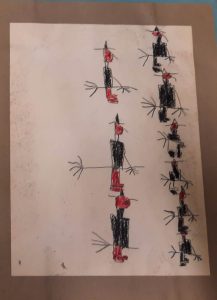Gavin’s book of witches
By Sarah S Pipkin, on 29 October 2021
Hidden in the Institute of Education’s Baines Archives is a small book entitled Gavin’s book of witches (BA/1/9/78).

The Baines Archives includes items related to the work of George and Judith Baines, who pioneered new teaching methods in the 1960s-1980s. The archive includes examples of student work from Eynsham County Primary School where George Baines worked as the headteacher. There are a number of small books written, illustrated, and bound by the students. One former pupil described the process:
‘A prominent memory that I have is of the book binding which not only completed a study but also became a feature. The technique is a cherished memory: the meticulous scraping of the lino block, the roller thick with sticky paint, the binding and the glue oozing out in all the wrong places, the pride of producing a book contained within a hardback.’
Gavin’s book of witches is one such example of student work. It was produced by a young pupil, probably named Gavin, who was probably still learning to write. The teacher has written the text for Gavin to copy underneath. It was then illustrated with original drawings.

The book is very short – just six pages in total. A transcription of it follows:

My witch is flying. She is going to the witches party.

She gets there first then all these come.

The witches are singing and eating at their party.
Gavin’s book of witches is the perfect Halloween story.
If you’d like to see more examples of workbooks from the Baines collection, ‘A Book of Bones’ and ‘My Book about the Potato’ are both featured in our online exhibition ‘Word as Art: Beauty in the Archives.’
 Close
Close



 The stories include ‘Battle of Frogs and Mice’, a short animal epic ascribed to Homer in the ancient world and ‘The Three Caskets’ which was used in Shakespeare’s Merchant of Venice. The book also contains a couple of firsts: the first appearance of a Norwegian folk tale ‘The History of Asim and Asgard’ and the first publication of Scott’s poem ‘The Bonnets of Bonny Dundee’ (Hahn, 2015, p. 127). In addition, there are writings by the prolific author of adult and children’s stories Maria Edgeworth (1768 – 1849) who also wrote the well-known education treatise
The stories include ‘Battle of Frogs and Mice’, a short animal epic ascribed to Homer in the ancient world and ‘The Three Caskets’ which was used in Shakespeare’s Merchant of Venice. The book also contains a couple of firsts: the first appearance of a Norwegian folk tale ‘The History of Asim and Asgard’ and the first publication of Scott’s poem ‘The Bonnets of Bonny Dundee’ (Hahn, 2015, p. 127). In addition, there are writings by the prolific author of adult and children’s stories Maria Edgeworth (1768 – 1849) who also wrote the well-known education treatise 